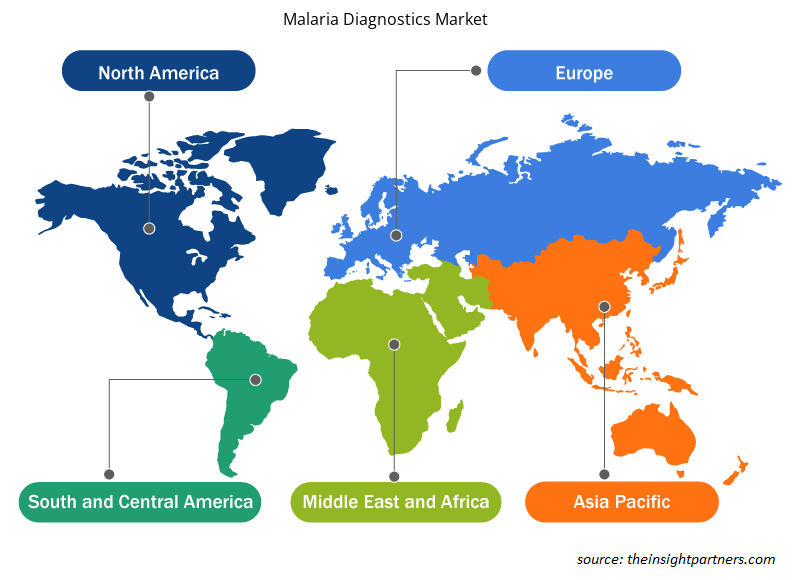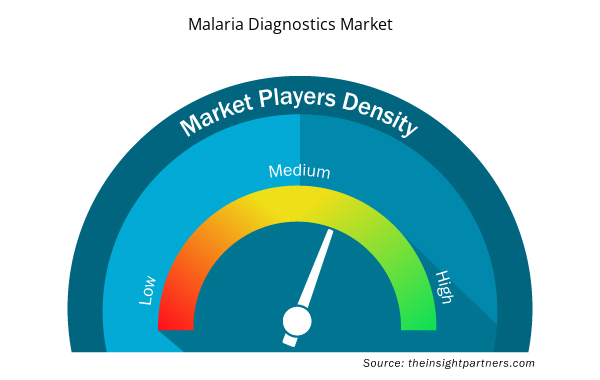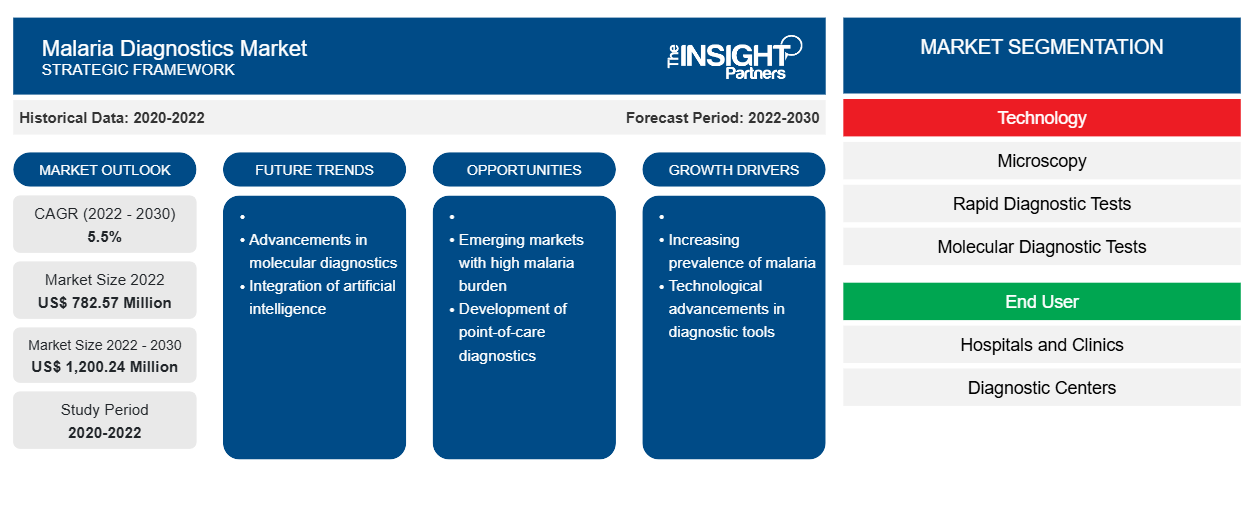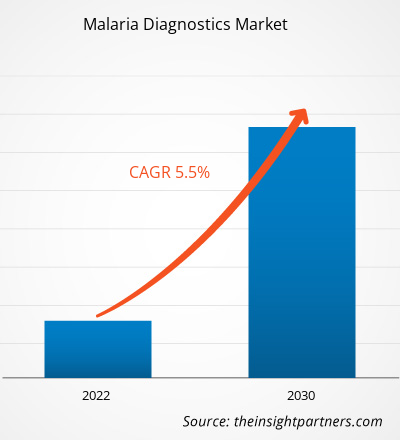[Informe de investigación] Se proyecta que el tamaño del mercado de diagnóstico de malaria crecerá de US$ 782,57 millones en 2022 a US$ 1200,24 millones en 2030; se estima que el mercado registrará una CAGR del 5,5% durante 2022-2030.
Perspectivas del mercado y opinión de analistas:
La malaria es una enfermedad potencialmente mortal causada por el parásito Plasmodium. El mercado de diagnóstico de la malaria está creciendo debido a la alta incidencia de la malaria en los países de bajos ingresos y a los programas de eliminación de la malaria implementados a nivel mundial por organizaciones internacionales y nacionales. El creciente lanzamiento de herramientas de diagnóstico avanzadas y el aumento de las actividades de investigación para terapias efectivas están contribuyendo aún más al crecimiento del mercado.
Antes de la pandemia de COVID-19, casi un tercio de los países endémicos estaban avanzando hacia los objetivos internacionales. Muchos países con baja incidencia formaban parte de la "Iniciativa de eliminación 2025" de la OMS, que está representada por un grupo de 25 países que se esfuerzan por eliminar potencialmente la malaria para 2025. Por otro lado, el progreso se estancó en aproximadamente un tercio de los países, mientras que en los demás países, la incidencia de la malaria aumentó. Los países con mayores cargas de enfermedad están mostrando una mayor inclinación a utilizar los datos de las pruebas de diagnóstico para estratificar y centrar las intervenciones geográficamente adecuadas, independientemente de la importancia que siguen teniendo las pruebas y el cribado en los intentos de erradicación.
Los casos y las muertes por malaria aumentaron durante el primer año de la epidemia de COVID-19 debido a pequeñas interrupciones en la gestión de los casos y las medidas de prevención. No obstante, gracias a los esfuerzos de cooperación de la OMS, los Programas Nacionales contra la Malaria y los asociados, se evitó un posible escenario peor (la duplicación de las muertes por malaria). Las dificultades para obtener los suministros necesarios contra la malaria y el patrón incierto de cómo la pandemia afectó en última instancia a las medidas de gestión de la malaria.
Factores impulsores del crecimiento:
La malaria, una de las enfermedades febriles agudas, es causada por parásitos del género Plasmodium y se propaga a través de mosquitos Anopheles hembra infectados. Cinco especies de parásitos en los seres humanos causan principalmente malaria, y dos de estas especies, Plasmodium falciparum y P. vivax, se consideran la mayor amenaza. Además, P. falciparum es el parásito de la malaria más mortal y está más extendido en el continente africano. Además, P. vivax es el parásito de la malaria dominante en la mayoría de los países fuera del África subsahariana. Según el Informe Mundial sobre la Malaria (WMR) 2020 de la Organización Mundial de la Salud (OMS), se notificaron 241 millones de casos de malaria en todo el mundo, en comparación con los 227 millones de casos registrados en 2019. Según la misma fuente, el número de muertes causadas por la malaria aumenta en 69.000 al año. Aproximadamente dos tercios de estas muertes, es decir, 47.000, fueron causadas por interrupciones en los servicios de atención de la salud durante la pandemia de COVID-19; el tercio restante de las muertes, es decir, 22.000, reflejó un cambio reciente en la metodología de la OMS para calcular la mortalidad por malaria (independientemente de las interrupciones por COVID-19).
En 2020, aproximadamente el 95 % de los casos mundiales y aproximadamente el 96 % de las muertes causadas por malaria se notificaron en la región africana de la OMS, y aproximadamente el 80 % del total de muertes notificadas se dieron en niños de 5 años o menos. Según WMR 2021, aproximadamente el 2 % de la carga mundial de malaria se registró en los países del sudeste asiático, donde la India representó el 83 % de los casos estimados de malaria y el 82 % de las muertes asociadas con la enfermedad en 2020. Por lo tanto, la creciente prevalencia de la malaria en diferentes regiones a nivel mundial impulsa el crecimiento del mercado de diagnóstico de la malaria.
En el mercado hay un número limitado de productos precalificados por la OMS que no son mRDT de Pf. A pesar de la disponibilidad de una amplia gama de productos mRDT precalificados por la OMS, la demanda se concentra en torno a un subconjunto preferido de productos y fabricantes específicos. Esto limita la capacidad del mercado para garantizar la diversidad, la seguridad y la capacidad de producción del suministro. En consonancia con esto, los fabricantes se enfrentan a desafíos como la baja demanda de productos de algunos países, así como su renuencia y falta de interés en adoptar productos alternativos. La adopción de marcas alternativas puede desencadenarse por el cambio de marcas seleccionadas para los algoritmos nacionales o por las implicaciones de costos.
Personalice este informe según sus necesidades
Obtendrá personalización en cualquier informe, sin cargo, incluidas partes de este informe o análisis a nivel de país, paquete de datos de Excel, así como también grandes ofertas y descuentos para empresas emergentes y universidades.
- Obtenga las principales tendencias clave del mercado de este informe.Esta muestra GRATUITA incluirá análisis de datos, desde tendencias del mercado hasta estimaciones y pronósticos.
Segmentación y alcance del informe:
El “mercado de diagnóstico de la malaria” está segmentado en función de la tecnología y el usuario final. El mercado de diagnóstico de la malaria, por tecnología, está segmentado en microscopía, pruebas de diagnóstico rápido (RDT) y pruebas de diagnóstico molecular . El segmento de pruebas de diagnóstico rápido (RDT) tuvo la mayor participación de mercado en 2022 y se estima que registrará la CAGR más alta del mercado durante 2022-2030. El mercado de diagnóstico de la malaria, por usuario final, se divide en hospitales y clínicas, centros de diagnóstico y otros. El segmento de hospitales y clínicas tuvo la mayor participación de mercado en 2022. Se espera que el segmento de centros de diagnóstico registre la CAGR más alta del mercado durante 2022-2030.
Análisis segmental:
El mercado de diagnóstico de malaria, por tecnología, está segmentado en microscopía, pruebas de diagnóstico rápido (RDT) y pruebas de diagnóstico molecular.
El segmento de pruebas de diagnóstico rápido (PDR) tuvo la mayor participación del mercado en 2022 y se proyecta que registre la CAGR más alta del mercado durante 2022-2030. Al demostrar la presencia de parásitos de la malaria en la sangre humana, las pruebas de diagnóstico rápido (PDR) de malaria ayudan en el diagnóstico de la malaria. Las PDR ofrecen una alternativa al diagnóstico basado en la clínica o la microscopía, especialmente en situaciones en las que el acceso a servicios de microscopía de alta calidad es limitado. Plasmodium falciparum o P. vivax es la única especie que ciertas PDR pueden identificar, pero otras pueden identificar cuatro especies: P. falciparum, P. vivax, P. malariae y P. ovale. Por lo general, se utiliza un pinchazo en el dedo para extraer sangre para la prueba.
El mercado de diagnóstico de la malaria, por usuario final, está segmentado en hospitales y clínicas, centros de diagnóstico y otros. Los hospitales y las clínicas están evolucionando notablemente con el creciente número de pacientes en todo el mundo. Ofrecen tratamientos altamente efectivos en entornos de bajo costo. El creciente énfasis en el uso de pruebas rápidas de diagnóstico por sus tiempos de respuesta rápidos, bajos costos y accesibilidad conveniente es una de las principales causas del predominio de las clínicas en el mercado de diagnóstico de la malaria.
Análisis regional:
El mercado mundial de diagnóstico de la malaria está segmentado geográficamente en América del Norte, Europa, Asia Pacífico, América del Sur y Central, y Oriente Medio y África. Debido a las crecientes inversiones de los países desarrollados como Estados Unidos y Canadá, las mayores poblaciones de pacientes y el creciente énfasis de la Organización Mundial de la Salud (OMS) en reducir la tasa de mortalidad por malaria en los países africanos, se prevé que la región de Oriente Medio y África mantenga su dominio del mercado durante el período de pronóstico. Según los datos publicados por la OMS en julio de 2022, es probable que el África subsahariana represente aproximadamente el 95% de los casos de la enfermedad y el 96% de las muertes.
Perspectivas regionales del mercado de diagnóstico de la malaria
Los analistas de Insight Partners explicaron en detalle las tendencias y los factores regionales que influyen en el mercado de diagnóstico de la malaria durante el período de pronóstico. Esta sección también analiza los segmentos y la geografía del mercado de diagnóstico de la malaria en América del Norte, Europa, Asia Pacífico, Oriente Medio y África, y América del Sur y Central.

- Obtenga datos regionales específicos para el mercado de diagnóstico de malaria
Alcance del informe de mercado sobre diagnóstico de la malaria
| Atributo del informe | Detalles |
|---|---|
| Tamaño del mercado en 2022 | US$ 782,57 millones |
| Tamaño del mercado en 2030 | US$ 1.200,24 millones |
| CAGR global (2022-2030) | 5,5% |
| Datos históricos | 2020-2022 |
| Período de pronóstico | 2022-2030 |
| Segmentos cubiertos | Por tecnología
|
| Regiones y países cubiertos | América del norte
|
| Líderes del mercado y perfiles de empresas clave |
|
Densidad de actores del mercado de diagnóstico de malaria: comprensión de su impacto en la dinámica empresarial
El mercado de diagnóstico de la malaria está creciendo rápidamente, impulsado por la creciente demanda de los usuarios finales debido a factores como la evolución de las preferencias de los consumidores, los avances tecnológicos y una mayor conciencia de los beneficios del producto. A medida que aumenta la demanda, las empresas amplían sus ofertas, innovan para satisfacer las necesidades de los consumidores y aprovechan las tendencias emergentes, lo que impulsa aún más el crecimiento del mercado.
La densidad de actores del mercado se refiere a la distribución de las empresas o firmas que operan dentro de un mercado o industria en particular. Indica cuántos competidores (actores del mercado) están presentes en un espacio de mercado determinado en relación con su tamaño o valor total de mercado.
Las principales empresas que operan en el mercado de diagnóstico de malaria son:
- Acceso Bio., Inc.
- Laboratorios Abbott
- Corporación Médica Premier Pvt. Ltd.
- Sysmex Partec GmbH
- BioMérieux
Descargo de responsabilidad : Las empresas enumeradas anteriormente no están clasificadas en ningún orden particular.

- Obtenga una descripción general de los principales actores clave del mercado de diagnóstico de malaria
Desarrollos industriales y oportunidades futuras:
A continuación se enumeran varios desarrollos estratégicos de los principales actores que operan en el mercado de diagnóstico de malaria:
- En febrero de 2022, el Instituto de Investigación Médica de Kenia (KEMRI) lanzó Plasmochek para la detección de la malaria. Plasmochek está diseñado para detectar el plasmodium, un parásito responsable de la malaria. El kit utiliza anticuerpos específicos contra la proteína II rica en histidina de Plasmodium falciparum y la lactato deshidrogenasa de Plasmodium para detectar infecciones por malaria.
- En diciembre de 2019, Access Bio y Global Good (un socio colaborador de la primera) desarrollaron una nueva prueba de diagnóstico rápido ultrasensible (uRDT) que es cinco veces más sensible a la hora de identificar antígenos de la proteína 2 rica en histidina (HRP2) que las uRDT disponibles actualmente. Además, se han creado diversas herramientas para mejorar el diagnóstico de la malaria.
Panorama competitivo y empresas clave:
Access Bio., Inc.; Abbott Laboratories; Premier Medical Corporation Pvt. Ltd.; Sysmex Partec GmbH; bioMerieux; Beckman Coulter Inc.; Siemens Healthineers; Leica Microsystems GmbH; Nikon Corporation; Olympus Corporation; y Bio-Rad Laboratories Inc. son las empresas más importantes en el mercado de diagnóstico de la malaria. Estas empresas se centran en nuevas tecnologías, la actualización de productos existentes y las expansiones geográficas para satisfacer la creciente demanda de los consumidores en todo el mundo.
- Análisis histórico (2 años), año base, pronóstico (7 años) con CAGR
- Análisis PEST y FODA
- Tamaño del mercado Valor/volumen: global, regional, nacional
- Industria y panorama competitivo
- Conjunto de datos de Excel


- Medical Audiometer Devices Market
- Compounding Pharmacies Market
- Embolization Devices Market
- Sexual Wellness Market
- Authentication and Brand Protection Market
- Animal Genetics Market
- Dairy Flavors Market
- Electronic Data Interchange Market
- Smart Parking Market
- Pharmacovigilance and Drug Safety Software Market

Report Coverage
Revenue forecast, Company Analysis, Industry landscape, Growth factors, and Trends

Segment Covered
This text is related
to segments covered.

Regional Scope
North America, Europe, Asia Pacific, Middle East & Africa, South & Central America

Country Scope
This text is related
to country scope.
Preguntas frecuentes
Asia Pacific is expected to be the fastest growing region in the malaria diagnostics market. The growth of the market in Asia Pacific is anticipated to grow at a faster pace owing to factors such as growing need for superior treatment solutions, increasing focus on research and development activities. Additionally, India reported an 83.34% reduction in malaria morbidity and a 92% decrease in associated mortality during 2000–2019. The Centers for Disease Control and Prevention (CDC) claims that pregnant women are three times more susceptible to malaria infections as compared to others. Thus, rapid diagnosis and subsequent treatment plans are essential, which favor the growth of the malaria diadnostics market in India.
The malaria diagnostics market, based on end user, classified into hospitals and clinics, diagnostic centers, and others. The hospitals and clinics segment held the largest market share in 2022. The diagnostic centers segment is expected to register the highest CAGR in the market during 2022–2030.
The malaria diagnostics market, based on technology, is segmented into microscopy, rapid diagnostic tests (RDTs), and molecular diagnostic tests. The rapid diagnostic tests (RDTs) segment held the largest market share in 2022 and is estimated to register the highest CAGR in the market during 2022–2030.
Middle East and Africa holds the largest market share in malaria diagnostics market. Growing incidences of malaria is leading to increasing demand for malaria diagnostics. The market growth is owing to factors such as growing demand for rising awareness regarding malaria treatment and rising disposable income.
The factors that are driving growth of the market are increasing research and development activities and advancements in informatic solutions and imaging systems.
Malaria is a life-threatening disease caused by the plasmodium parasite. The malaria diagnostics market is growing due to the high incidence of malaria in low-income countries and globally implemented malaria elimination programs by international and national organizations. The increasing launches of advanced diagnostic tools and rising research activities for effective therapeutics are further contributing to the growth of the market.
The malaria diagnostics market majorly consists of the players such as Access Bio., Inc.; Abbott Laboratories; Premier Medical Corporation Pvt. Ltd.; Sysmex Partec GmbH; bioMerieux; Beckman Coulter Inc.; Siemens Healthineers; Leica Microsystems GmbH; Nikon Corporation; Olympus Corporation; and Bio-Rad Laboratories Inc. among others.
Trends and growth analysis reports related to Life Sciences : READ MORE..
The List of Companies - Malaria Diagnostics Market
- Access Bio., Inc.
- Abbott Laboratories
- Premier Medical Corporation Pvt. Ltd.
- Sysmex Partec GmbH
- bioMérieux
- Beckman Coulter, Inc.
- Siemens Healthineers
- Leica Microsystems GmbH
- Nikon Corporation
- Olympus Corporation
- Bio-Rad Laboratories, Inc.
The Insight Partners performs research in 4 major stages: Data Collection & Secondary Research, Primary Research, Data Analysis and Data Triangulation & Final Review.
- Data Collection and Secondary Research:
As a market research and consulting firm operating from a decade, we have published and advised several client across the globe. First step for any study will start with an assessment of currently available data and insights from existing reports. Further, historical and current market information is collected from Investor Presentations, Annual Reports, SEC Filings, etc., and other information related to company’s performance and market positioning are gathered from Paid Databases (Factiva, Hoovers, and Reuters) and various other publications available in public domain.
Several associations trade associates, technical forums, institutes, societies and organization are accessed to gain technical as well as market related insights through their publications such as research papers, blogs and press releases related to the studies are referred to get cues about the market. Further, white papers, journals, magazines, and other news articles published in last 3 years are scrutinized and analyzed to understand the current market trends.
- Primary Research:
The primarily interview analysis comprise of data obtained from industry participants interview and answers to survey questions gathered by in-house primary team.
For primary research, interviews are conducted with industry experts/CEOs/Marketing Managers/VPs/Subject Matter Experts from both demand and supply side to get a 360-degree view of the market. The primary team conducts several interviews based on the complexity of the markets to understand the various market trends and dynamics which makes research more credible and precise.
A typical research interview fulfils the following functions:
- Provides first-hand information on the market size, market trends, growth trends, competitive landscape, and outlook
- Validates and strengthens in-house secondary research findings
- Develops the analysis team’s expertise and market understanding
Primary research involves email interactions and telephone interviews for each market, category, segment, and sub-segment across geographies. The participants who typically take part in such a process include, but are not limited to:
- Industry participants: VPs, business development managers, market intelligence managers and national sales managers
- Outside experts: Valuation experts, research analysts and key opinion leaders specializing in the electronics and semiconductor industry.
Below is the breakup of our primary respondents by company, designation, and region:

Once we receive the confirmation from primary research sources or primary respondents, we finalize the base year market estimation and forecast the data as per the macroeconomic and microeconomic factors assessed during data collection.
- Data Analysis:
Once data is validated through both secondary as well as primary respondents, we finalize the market estimations by hypothesis formulation and factor analysis at regional and country level.
- Macro-Economic Factor Analysis:
We analyse macroeconomic indicators such the gross domestic product (GDP), increase in the demand for goods and services across industries, technological advancement, regional economic growth, governmental policies, the influence of COVID-19, PEST analysis, and other aspects. This analysis aids in setting benchmarks for various nations/regions and approximating market splits. Additionally, the general trend of the aforementioned components aid in determining the market's development possibilities.
- Country Level Data:
Various factors that are especially aligned to the country are taken into account to determine the market size for a certain area and country, including the presence of vendors, such as headquarters and offices, the country's GDP, demand patterns, and industry growth. To comprehend the market dynamics for the nation, a number of growth variables, inhibitors, application areas, and current market trends are researched. The aforementioned elements aid in determining the country's overall market's growth potential.
- Company Profile:
The “Table of Contents” is formulated by listing and analyzing more than 25 - 30 companies operating in the market ecosystem across geographies. However, we profile only 10 companies as a standard practice in our syndicate reports. These 10 companies comprise leading, emerging, and regional players. Nonetheless, our analysis is not restricted to the 10 listed companies, we also analyze other companies present in the market to develop a holistic view and understand the prevailing trends. The “Company Profiles” section in the report covers key facts, business description, products & services, financial information, SWOT analysis, and key developments. The financial information presented is extracted from the annual reports and official documents of the publicly listed companies. Upon collecting the information for the sections of respective companies, we verify them via various primary sources and then compile the data in respective company profiles. The company level information helps us in deriving the base number as well as in forecasting the market size.
- Developing Base Number:
Aggregation of sales statistics (2020-2022) and macro-economic factor, and other secondary and primary research insights are utilized to arrive at base number and related market shares for 2022. The data gaps are identified in this step and relevant market data is analyzed, collected from paid primary interviews or databases. On finalizing the base year market size, forecasts are developed on the basis of macro-economic, industry and market growth factors and company level analysis.
- Data Triangulation and Final Review:
The market findings and base year market size calculations are validated from supply as well as demand side. Demand side validations are based on macro-economic factor analysis and benchmarks for respective regions and countries. In case of supply side validations, revenues of major companies are estimated (in case not available) based on industry benchmark, approximate number of employees, product portfolio, and primary interviews revenues are gathered. Further revenue from target product/service segment is assessed to avoid overshooting of market statistics. In case of heavy deviations between supply and demand side values, all thes steps are repeated to achieve synchronization.
We follow an iterative model, wherein we share our research findings with Subject Matter Experts (SME’s) and Key Opinion Leaders (KOLs) until consensus view of the market is not formulated – this model negates any drastic deviation in the opinions of experts. Only validated and universally acceptable research findings are quoted in our reports.
We have important check points that we use to validate our research findings – which we call – data triangulation, where we validate the information, we generate from secondary sources with primary interviews and then we re-validate with our internal data bases and Subject matter experts. This comprehensive model enables us to deliver high quality, reliable data in shortest possible time.


 Obtenga una muestra gratuita de este informe
Obtenga una muestra gratuita de este informe